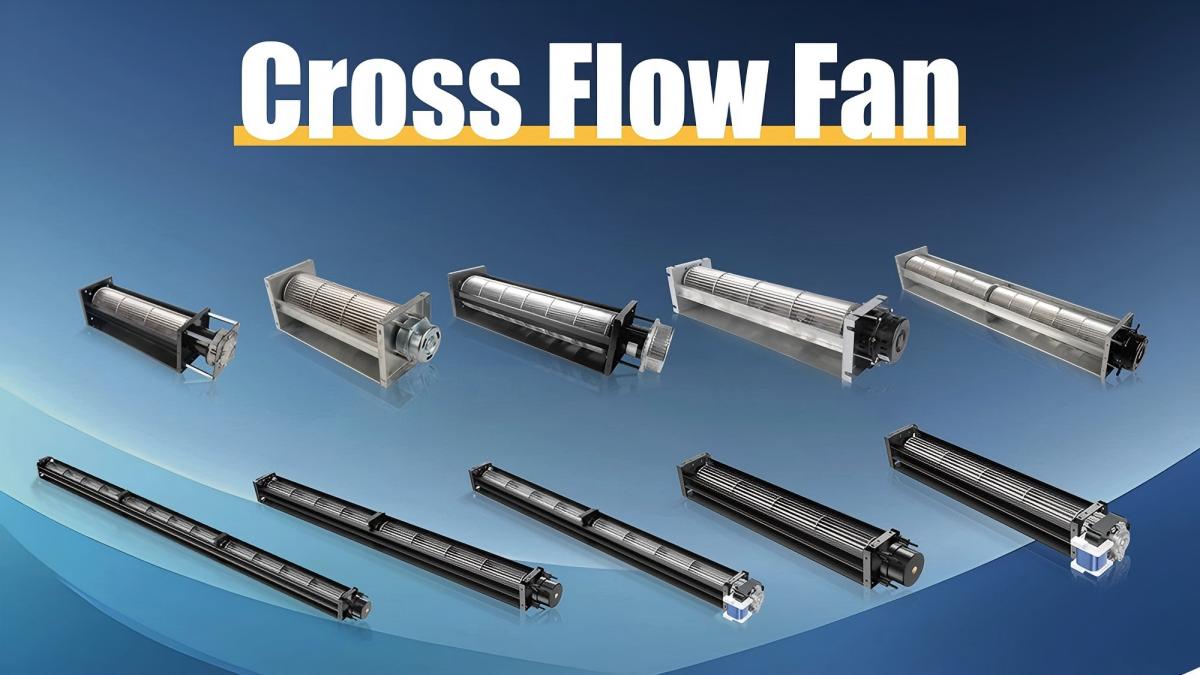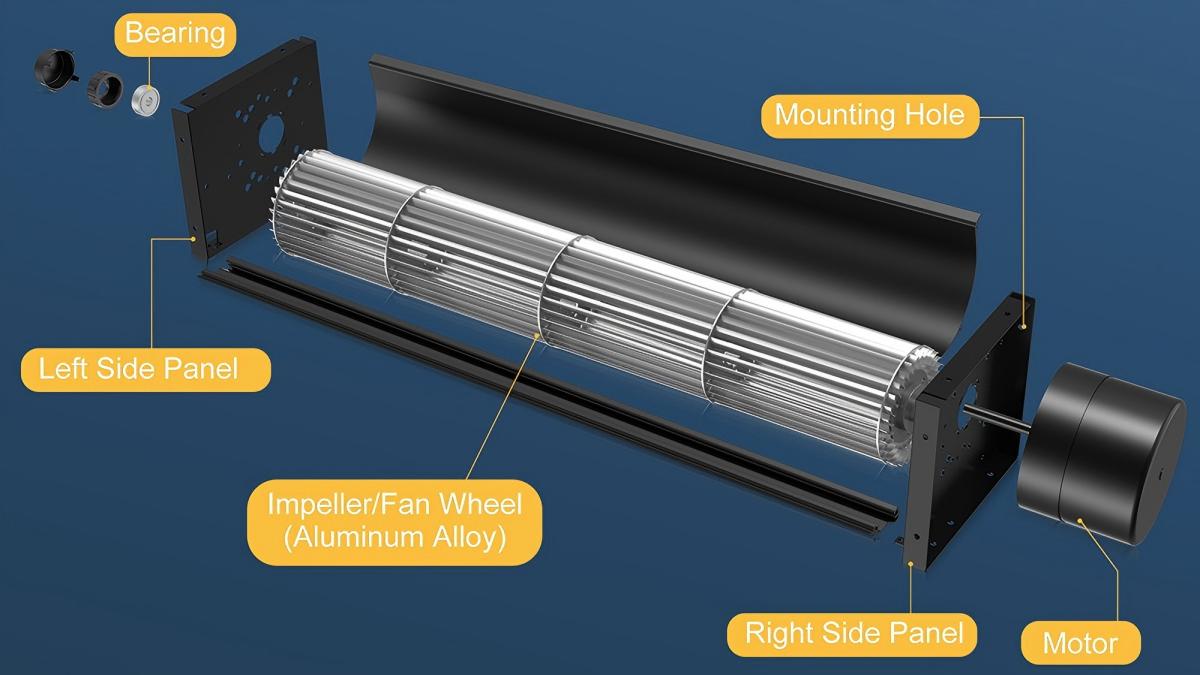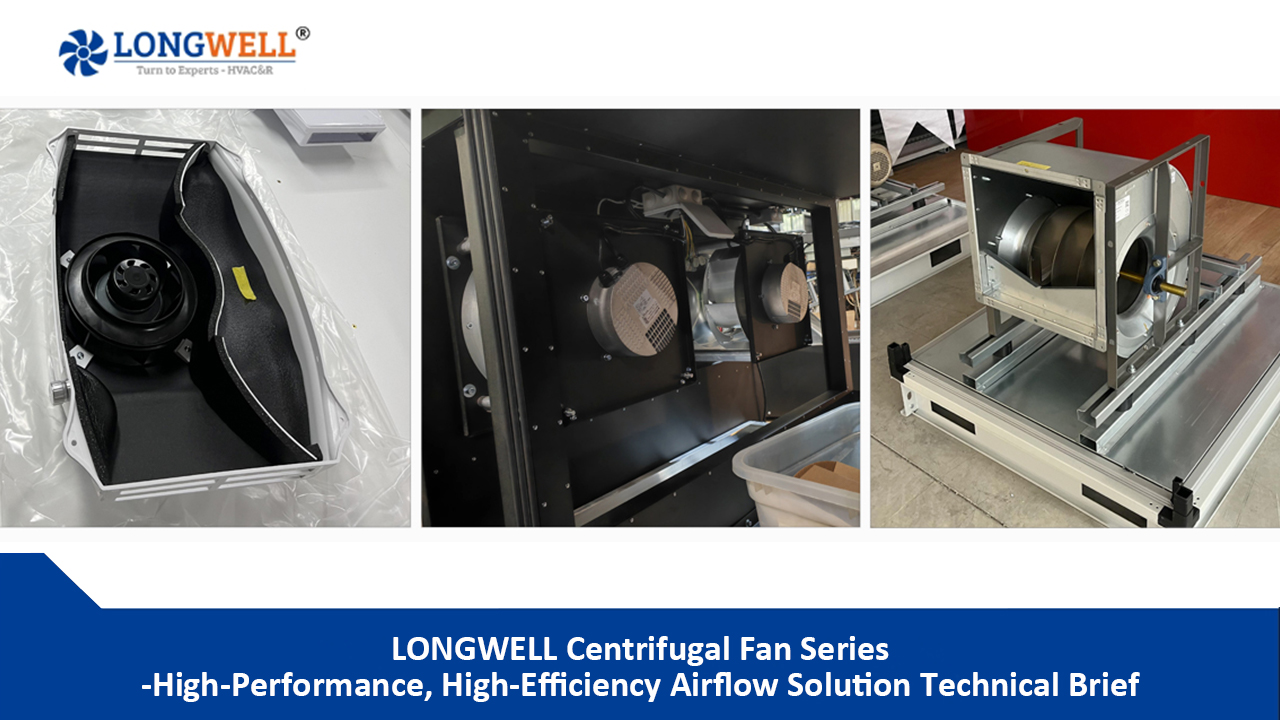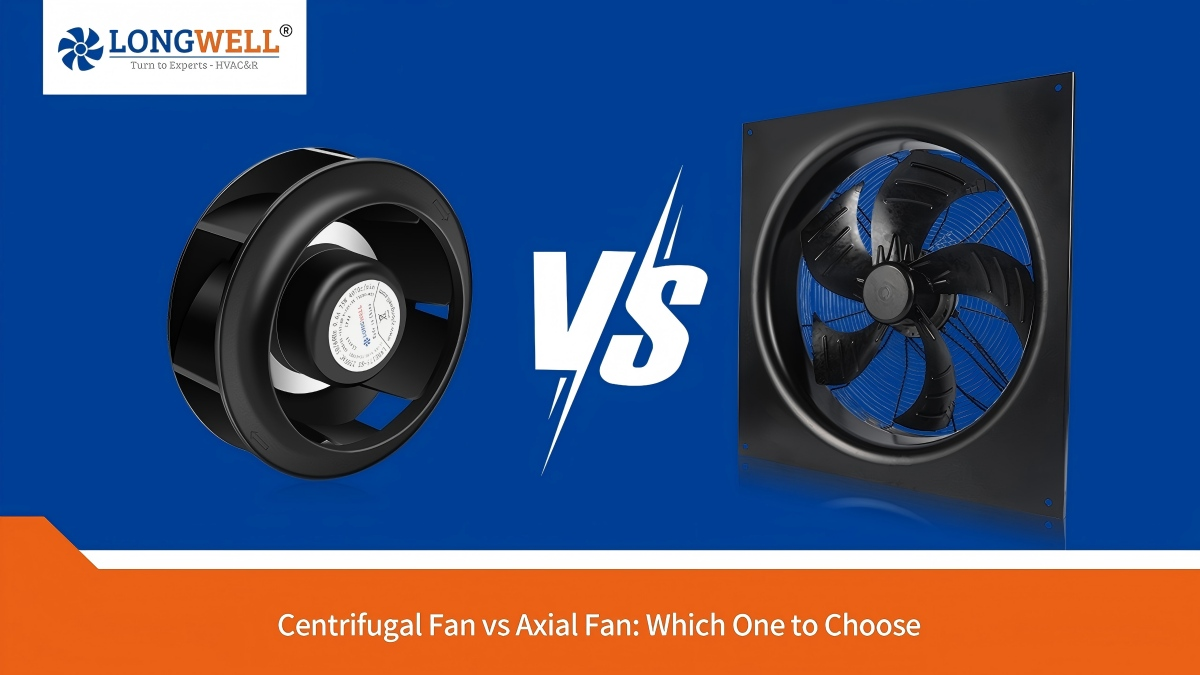
You want to pick the right cross flow fan, but it can feel tricky. Matching the fan’s size, airflow, noise, and power to your needs makes a big difference. Cross flow fans work best in spots that need steady airflow and low to medium pressure. When you match these fans to your space, you help keep comfort high and save energy. The table below shows how optimized cross flow fan designs can boost airflow and cut noise in air conditioners:
Parameter / Metric | Value / Description |
|---|---|
Impeller blade count | 35 blades |
Impeller length | 600 mm |
Impeller outer diameter | 120 mm |
Performance improvements | Better airflow, less noise, and higher efficiency |
You’ll find that LONGWELL offers many cross flow fans for different uses. Take it step by step, and you’ll find the best fit for your application.
Key Takeaways
Measure your available space carefully to pick a fan that fits well and allows good airflow.
Match the fan’s airflow, pressure, noise level, power, and material to your specific needs and environment.
Choose fans with quiet operation for noise-sensitive places and durable materials for tough conditions.
Check product data sheets to compare airflow, pressure, noise, and power before buying.
Clean and maintain your fan regularly using genuine parts to keep it running efficiently and last longer.
Application Needs
Common Uses
You see cross flow fans in many places because they move air smoothly and evenly. These fans work well in devices that need steady airflow across a wide area. Here are some interesting ways people use cross flow fans:
In the 1970s, engineers tested cross flow fans in aircraft wings for the U.S. Navy. They found that changing the fan design improved efficiency from 59% to 71%.
By adjusting the shape of the fan housing and the angle of the blades, they boosted casing efficiency from 37% to 61%.
Some designs even used rotary engines to power cross flow fans for vertical takeoff aircraft.
When combined with thick airfoils, these fans helped planes get better lift and smoother airflow, making them more effective in flight.
Today, you find cross flow fans in air conditioners, heaters, and electronics. They also help with cooling applications in data centers and electric vehicles. You can count on these fans for reliable performance in many industries.
Environmental Demands
You need to think about where your fans will run. Cross flow fans shine in places that need quiet operation, low power use, and even airflow. Market studies show that these fans are popular in HVAC systems and electronics because they save energy and keep noise down. Their compact size makes them easy to fit into tight spaces.
Tip: If you want your fans to last, make sure they can handle the heat, dust, and humidity in your space.
Tests show that airflow can change if the air moves across the fan inlet in a strange way. This can lower thermal performance by more than 30%. If you place your fans too close to the ground or near strong winds, you might see a drop in how much air they move. Careful placement and setup help keep airflow steady and your system running well.
Considerations Before Selecting
When you start looking for the right cross flow fans, you need to think about a few important things. These considerations before selecting will help you avoid problems and get the best performance for your application.
Size and Space
You should always check how much space you have for your fan. The size of your cross flow fan affects how much air it can move and how well it fits in your system. Tests on different fan sizes show that changing the length of the rotor can increase the amount of air the fan moves, even if you keep the diameter and speed the same. If you have more room in the axial direction, you can use a longer fan to boost airflow. The shape of the casing and the thickness of the walls also change how the air moves inside the fan. These small changes can make a big difference in pressure and efficiency.
Make sure you measure your available space before you choose a fan.
Try to avoid placing fans near walls or other objects that block airflow.
If you have a tight spot, look for compact cross flow fans that still give you good performance.
Airflow and Pressure
You want your cross flow fan to deliver the right amount of airflow and pressure for your needs. Different applications need different airflow rates. For example, cooling electronics might need steady, gentle airflow, while HVAC systems may need stronger airflow to move air across a room. Experts use special wind tunnels and test setups to measure how much air a fan can move and how much pressure it can create. These tests help you compare different fans and pick the one that matches your requirements.
When you look at airflow and pressure, think about:
How much air your system needs to stay cool or comfortable.
The resistance or backpressure in your system, which can lower airflow.
Matching the fan’s airflow and pressure to your application for the best results.
Tip: If you are not sure how much airflow you need, LONGWELL can help you figure it out with real-world data and expert advice.
Noise Level
Nobody likes a noisy fan, especially in quiet spaces like offices or bedrooms. The noise level of cross flow fans depends on how fast they spin and how they are built. Studies show that noise levels change a lot depending on where you use the fan. In cars, fans can be loud, so engineers look at things like loudness and sharpness to make them less annoying. In factories, safety comes first, so there are rules about how loud fans can be to protect your hearing. For most home or office uses, you want a fan that runs quietly but still moves enough air.
Check the noise rating of each fan before you buy.
If you need a quiet space, pick a fan with a low sound pressure level.
Remember, sometimes you have to balance noise and airflow to get the right mix.
Power and Voltage
You need to match your fan’s power and voltage to your system. If you pick the wrong voltage, your fan might not work or could even get damaged. Most cross flow fans come in different voltage options, like 12V, 24V, or 220V. You should also check how much power the fan uses. Lower power fans save energy, but you still need enough power to get the airflow you want.
Always check your system’s voltage before you choose a fan.
Look for fans with high energy efficiency to save on power bills.
If you have special power needs, LONGWELL can help you find the right fan.
Material and Durability
The materials used in your fan matter a lot, especially if you use it in tough places. Some cross flow fans have metal blades for extra strength, while others use plastic to keep things light and quiet. If your fan will run in a hot, dusty, or wet place, you need one made from strong, durable materials. Good materials help your fan last longer and keep working well.
Pick fans with corrosion-resistant parts for humid or outdoor spaces.
For high temperatures, choose fans with heat-resistant materials.
LONGWELL offers fans with different materials to fit your needs.
Mounting and Installation
You want your fan to be easy to install and fit securely in your system. Some cross flow fans come with special brackets or mounts to make installation simple. You should also think about how you will connect the fan to your power supply and how you will keep it stable during use.
Check the mounting options before you buy.
Make sure you have enough room for wiring and airflow.
Avoid blocking the fan’s inlet or outlet, as this can lower performance.
Note: Careful installation helps you get the most out of your fan and keeps it running smoothly.
When you look at all these considerations before selecting, you set yourself up for success. You avoid common mistakes, like picking a fan that is too big or too loud, and you make sure your system runs well. You also improve energy efficiency and keep your equipment safe. If you ever feel unsure, LONGWELL’s team can help you review your needs and pick the best cross flow fans for your application.
Cross Flow Fan Impellers

Blade Design
When you look at cross flow fan impellers, you will notice that blade design makes a big difference. The shape and angle of the blades decide how much air your fans can move and how quietly they run. Engineers have tested many blade shapes to see what works best. Here are some findings:
Forward-swept blades with angles like 10°, 15°, and 20° can boost efficiency. A 20° sweep gives you about 1.5% more efficiency and 15 Pa more pressure at low flow.
If you use forward-swept blades, you can get up to 7.5% better efficiency at low flow compared to regular blades. This also helps your cross flow fan impellers work in a wider range.
Starting the forward sweep at 60% of the blade span gives you the best results, with up to 2% more efficiency and 40 Pa higher pressure.
Some cross flow fan impellers use equal–variable circulation blades. These increase the speed of air at the blade tips and roots, making your fans work better.
Computer models show that forward-swept blades help reduce air flow separation, which means smoother and more stable airflow.
You can see that small changes in blade design can make your cross flow fan impellers much more effective.
Material Choices
The material you pick for your cross flow fan impellers affects how long they last and how well they work. Here is a quick look at the most common materials:
Material | Durability & Corrosion Resistance | Weight | Cost | Thermal Conductivity | Suitability / Application Highlights |
|---|---|---|---|---|---|
Good, but less than stainless steel | Lightweight | Moderate | High | Great for heat dissipation; best for portable devices and aerospace | |
Least durable, low resistance | Lightest | Lowest | Lowest | Cheap and flexible; good for low-temp, dry places | |
Stainless Steel | Highest durability and resistance | Heaviest | Highest | Lower than aluminum | Perfect for tough jobs; handles humidity, chemicals, and high temps |
If you need cross flow fan impellers for harsh places, stainless steel is your best bet. For lighter or cheaper fans, plastic or aluminum might work better.
Performance Impact
The design and material of your cross flow fan impellers change how your fans perform. When you change the shape of the impeller or the casing, you can see big differences in airflow and pressure. For example, making the bell mouth smaller can lower the pressure rise. If the air does not flow evenly into the impeller, your cross flow fans might lose 2 to 4% in pressure and efficiency. Some changes, like adding special casing treatments, help your cross flow fan impellers handle more air and reduce flow problems.
Researchers have found that the geometry of cross flow fan impellers affects the way air moves inside the fan. This changes how well your fans work. Even after many years of study, engineers still test new impeller shapes to get the best mix of airflow, pressure, and efficiency. If you want your cross flow fans to run at their best, pay close attention to the design and material of your cross flow fan impellers.
Cross Flow Fan Selection Steps

Choosing the right cross flow fan for your project can feel like a big job. If you break it down into simple steps, you can find the best match for your needs. Here’s a step-by-step guide to help you make the right choice.
Define Requirements
Start by thinking about what you need from your fans. Ask yourself these questions:
What do you want your cross flow fan to do?
Where will you use it?
How much space do you have for the fan?
Do you need quiet operation, or is noise not a big deal?
Will the fan face heat, dust, or moisture?
Write down your answers. This list will help you stay focused as you look at different cross flow fans. If you know your needs, you can avoid picking a fan that won’t work well in your space.
Tip: Think about the environment. If your fan will run in a hot or dusty place, you need strong materials and a design that can handle tough conditions.
Match Specifications
Now, take your list of needs and compare them to the features of different cross flow fans. Look at these key points:
Feature | What to Check |
|---|---|
Size | Will the fan fit in your space? |
Airflow | Does the fan move enough air for your needs? |
Pressure | Can the fan handle any resistance in your system? |
Noise Level | Is the fan quiet enough for your location? |
Power & Voltage | Does it match your power supply? |
Material | Will it last in your environment? |
Mounting Options | Is it easy to install and secure? |
You want to match each feature to your requirements. For example, if you need a quiet fan for a bedroom, pick one with a low noise rating. If you need a fan for a hot area, choose one with heat-resistant materials.
Note: Cross flow fan impellers play a big part in how much air your fan can move and how quiet it runs. Check the blade design and material for the best results.
Consult Product Data
Don’t just guess—look at the numbers. Every cross flow fan comes with a data sheet or product guide. These documents show you:
Airflow rates
Pressure curves
Noise levels
Power use
Dimensions
Read these details carefully. You can compare different fans side by side. If you see a chart, look for the airflow and pressure at the speed you plan to use. Some fans may look the same, but their cross flow fan impellers can make a big difference in performance.
If you want to make things easier, create a checklist like this:
- [ ] Fan fits my space
- [ ] Airflow meets my needs
- [ ] Noise level is acceptable
- [ ] Power and voltage match my system
- [ ] Material suits my environment
- [ ] Mounting is simple
Check off each box as you go. This way, you won’t miss anything important.
Seek Expert Advice
Sometimes, you might feel stuck or unsure. Maybe your project has special needs, or you want to get the most out of your cross flow fan impellers. That’s when you should talk to an expert.
LONGWELL’s technical support team can help you:
Pick the right cross flow fan for tricky spaces
Understand airflow and pressure data
Choose the best materials for your environment
Solve installation problems
If you have a complex project or need custom solutions, don’t guess. Reach out to LONGWELL’s experts. They know cross flow fans inside and out and can help you avoid costly mistakes.
Checklist for Cross Flow Fan Selection:
Define your requirements
Match fan specifications to your needs
Review product data and compare options
Ask for expert advice if you need it
By following these steps, you can find the perfect cross flow fan for your application. You’ll get better performance, longer life, and fewer headaches down the road.
Cross Flow Fan Model Examples and Performance Parameters
To make this more concrete, let’s look at some actual cross flow fan models and their typical parameters to help you better understand how to choose based on your needs.
Model Example 1: Small DC Cross Flow Fan (LWCD-25mm Series)
· Typical Application: Small electronic devices, portable air purifiers, desktop heaters, etc.
· Characteristics: Compact, low noise, DC powered, often used in scenarios with strict size and noise requirements.
Parameter / Metric | Value / Description |
Impeller Diameter | 25 mm |
Impeller Length | 150 mm |
Rated Voltage | 12 V DC |
Rated Current | 0.15 A |
Rated Power | 1.8 W |
Rated Speed | 3500 RPM |
Max Airflow | 20 m³/h (11.8 CFM) |
Max Static Pressure | 15 Pa (0.06 inH2O) |
Noise Level | 25 dB(A) |
Motor Type | Brushless DC (BLDC) Motor |
Bearing Type | Dual Ball Bearing |
Speed Control | PWM (Optional) |
Housing Material | Aluminum Alloy |
Weight | 0.15 kg |
Operating Temp | -10°C to 50°C |
Model Example 2: Medium AC Cross Flow Fan (AC-60mm Series)
· Typical Application: Air conditioner indoor units, fireplace blowers, heaters, air curtains, etc.
· Characteristics: AC powered, higher airflow, often comes with multiple speed control options.
Parameter / Metric | Model: AC-60800-220V (Example) |
Impeller Diameter | 60 mm |
Impeller Length | 800 mm |
Rated Voltage | 220 V AC |
Frequency | 50/60 Hz |
Rated Current | 0.45 A |
Rated Power | 85 W |
Rated Speed | 1800 RPM |
Max Airflow | 550 m³/h (324 CFM) |
Max Static Pressure | 80 Pa (0.32 inH2O) |
Noise Level | 42 dB(A) |
Motor Type | Shaded Pole Motor |
Bearing Type | Sleeve Bearing / Ball Bearing |
Speed Control | 2-speed/3-speed (Optional) |
Housing Material | Galvanized Steel / Aluminum Alloy |
Weight | 3.5 kg |
Operating Temp | -20°C to 60°C |
Model Example 3: High-Efficiency EC Cross Flow Fan (EC-80mm Series)
· Typical Application: High-end air conditioning systems, data center cooling, precise temperature control systems.
· Characteristics: Uses an EC (Electronically Commutated) motor for high efficiency, low noise, variable speed control, and significant energy savings.
Parameter / Metric | Model: EC-801000-230V (Example) |
Impeller Diameter | 80 mm |
Impeller Length | 1000 mm |
Rated Voltage | 230 V AC |
Frequency | 50/60 Hz |
Rated Current | 0.70 A |
Rated Power | 150 W |
Rated Speed | 2200 RPM |
Max Airflow | 900 m³/h (530 CFM) |
Max Static Pressure | 120 Pa (0.48 inH2O) |
Noise Level | 35 dB(A) |
Motor Type | EC External Rotor Motor |
Bearing Type | Ball Bearing |
Speed Control | 0-10V / PWM |
Housing Material | Extruded Aluminum Profile |
Weight | 5.0 kg |
Operating Temp | -20°C to 70°C |
Note: Actual performance data can vary based on testing conditions and specific models.
Mistakes to Avoid
Ignoring Space Limits
You might think any fan will fit, but space matters a lot. If you pick a fan that is too big, it will not fit in your system. A fan that is too small may not move enough air. Always measure your space before you buy. Check the length, width, and height. Make sure you leave room for airflow around the fan. If you skip this step, you could end up with a fan that blocks other parts or does not work well.
Tip: Draw a quick sketch of your setup. Mark where the fan will go. This helps you see if the fan will fit.
Overlooking Noise
Noise can sneak up on you. You might not notice it at first, but a loud fan can get annoying fast. This is extra important in quiet places like bedrooms, offices, or classrooms. Always check the noise rating before you choose a fan. Look for fans with lower decibel (dB) levels if you want a quiet space.
Ask yourself: Will the fan run near people?
If yes, pick a fan with a low noise rating.
If you need more airflow, try to find a balance between noise and performance.
Nobody wants a fan that sounds like a jet engine! 🛩️
Wrong Power Choice
Choosing the wrong power or voltage can cause big problems. If you use the wrong voltage, the fan might not start or could burn out. Always check your system’s voltage before you buy. Most cross flow fans come in 12V, 24V, or 220V options. Pick the one that matches your power supply.
Power Supply | Common Fan Voltage |
|---|---|
Battery | 12V or 24V |
Home Outlet | 220V |
Alert: Using the wrong voltage can damage your fan and your system.
Skipping Maintenance
Fans need care to keep working well. If you forget to clean or check your fan, dust and dirt can build up. This makes the fan work harder and can shorten its life. Set a reminder to clean your fan every few months. Check for loose parts or strange noises.
Clean the blades and housing.
Make sure nothing blocks the airflow.
Use only real replacement parts if something breaks.
Regular maintenance keeps your fan running smoothly and saves you money in the long run.
Maintenance Tips
Cleaning
You want your cross flow fan to last a long time. Cleaning is the first step. Dust and dirt can build up on the blades and inside the housing. This buildup makes your fan work harder and can lower airflow. Use a soft brush or a vacuum to remove dust from the blades. If you see sticky dirt, wipe it off with a damp cloth. Always turn off the power before you start cleaning. Try to clean your fan every few months, especially if you use it in a dusty place.
Tip: Set a reminder on your phone so you never forget to clean your fan!
Performance Checks
Checking your fan’s performance helps you catch problems early. Listen for strange noises when the fan runs. If you hear rattling or grinding, something might be loose or worn out. Watch how much air comes out. If the airflow feels weak, check for blockages or dirt. You can also look at the fan’s speed. If it spins slower than usual, it may need cleaning or a new part. Regular checks keep your fan running smoothly and help you avoid bigger issues later.
Make a checklist for your monthly fan check:
Listen for odd sounds
Feel for steady airflow
Look for dust or dirt
Check that the fan spins freely
Using Genuine Parts
When you need to replace a part, always use genuine parts from the manufacturer. These parts fit better and last longer. Using the wrong parts can cause damage or lower your fan’s performance. If you are not sure which part to buy, ask the supplier or check the manual. Genuine parts help your fan stay safe and reliable.
Note: LONGWELL offers real replacement parts for all their cross flow fans. Using these keeps your fan working its best.
Choosing the right fan starts with knowing what your space needs. You get better results when you match your fan’s size, airflow, noise, and power to your job. Industry research shows:
Different places, like hospitals or kitchens, need fans built for their own challenges.
New technology means fans must fit both size and performance needs.
Local rules and industry trends shape which fans work best.
If you want help, LONGWELL’s team can guide you. Take it step by step for the best outcome.
FAQ
What is a cross flow fan?
A cross flow fan moves air in a wide, even stream. You often see these fans in air conditioners, heaters, and electronics. They work best when you need steady airflow across a large area.
How do I know what size fan I need?
Measure the space where you want to put the fan. Check the length, width, and height. Pick a fan that fits with room for airflow. If you feel unsure, ask an expert for help.
Can I use a cross flow fan in a humid place?
Yes, you can use one in humid areas. Just make sure you pick a fan with corrosion-resistant materials. Stainless steel works well for wet or damp spots.
How often should I clean my cross flow fan?
You should clean your fan every few months. Dust and dirt can build up fast. Use a soft brush or vacuum. Always turn off the power before you start cleaning.



